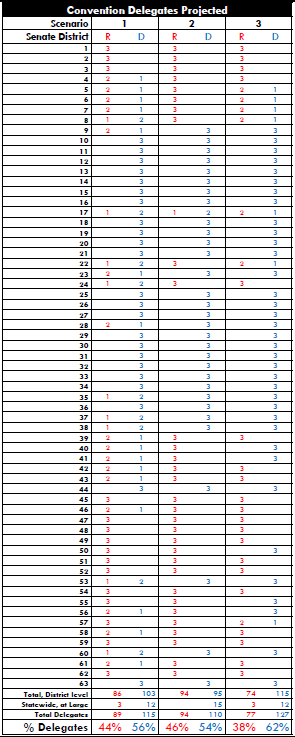There are more than 150 groups that are in opposition to the proposed ballot amendment for the constitutional convention. Pro-choice groups and anti-abortion rights groups. Pro-union groups and anti-union groups. Pro-gun rights groups and gun control groups. The common thread? Political power. The only logical reason these folks don’t want a New York State Constitutional Convention – a Con Con – is that they presently enjoy a toehold in Albany that they very much like. Upset the system and they have to reestablish a network and grapple with a new order where they may not have as much juice, and the last thing interest groups like is change, because it means that the power has shifted away from their control.
You know what that’s called? Democracy.
But we’re getting ahead of ourselves, because you have to ask, first, who would represent you if a Con Con actually came to pass (and for that to happen you’d have to vote in favor of a constitutional convention next Tuesday).
Let’s just say that the proposal squeaks through. In that case, a year from now, the same year we’ll have our first nationwide turnout to put our stamp on what we think of our representatives in Washington since Trump won the White House, we’d also vote in New York State on who we’d want to send to represent us at a Con Con. This vote would be conducted within present State Senate district lines, with each district sending three delegates. There would also be 15 statewide delegates, meaning all voters in the state would get to vote on that slate; remember that New York as a whole hasn’t elected a single Republican to any statewide office in over a decade.
Also know that New York is heavily Democratically tilted, so even Senate districts that have elected Republicans are closely divided, with more “purple” districts than purely red ones, and more solidly Democratic districts (blue) than solidly red ones. Knowing all of that we’ve laid out three potential scenarios for the breakdown of votes for delegates to a Con Con. The chart of these votes is below, and we use election law currently in place for these elections.
Scenario 1 44% R, 56% D
In this model we looked at vote winners in NY State Senate races in 2016 and allocated according to the vote splits (Democratic or Republican party), with the party sweeping if the district tilted greater than 55 percent for a single party.
If the margin was less than 10 percentage points, 2 delegates were allocated to the party of the winner of that Senate seat and 1 to other party. For example, in this model Sue Serino‘s district 41, which is closely divided, gets 2 Republicans and 1 Democrat. Simcha Felder is a special case; he’s from New York City where Democrats have an overwhelming advantage and is elected as a Democrat, but sides with the GOP in the Senate. So there we also assume a divided delegate election outcome.
At-large seats (there will be 15 delegates on every ballot throughout the state) are divided in this model, with 12 to Democrats, and 3 to Republicans, even though Democrats enjoy a vast enrollment edge in the state and regularly win statewide races. So, in general, this method tilts things slightly to the GOP.
Scenario 2 46% R, 54% D
In this model, for sake of argument, every single district is strictly divided along current Senate distribution. Meaning even closely divided districts that swing Republican get all three seats (unlikely in reality, again because those districts just don’t lean that hard to the right) for the Constitutional Convention. But because Felder’s situation is special, his district is still divided in this model, as in Scenario 1. Here we’ve swung all at-large delegates to the Democrats, but even a 50-50 split (again, unlikely, with Democrats outweighing Republicans more than 2-to-1 statewide) wouldn’t be enough for the Republicans to win the majority.
Scenario 3 38% R, 62% D
Here we’ve modeled the vote as a wave election. Considering current polling shows a strong backlash against Republicans, this scenario may hold sway, with Democrats having a strong year in 2018. In this model Democratic delegates sweep the district if that State Senate seat was won by that party in 2016 and Hillary Clinton carried that district in 2016. We allocate 3 delegates to the district if Republicans currently hold it and Trump carried the district. By contrast, if Democrats won the seat in the Senate and Trump still carried the district, we split the district with 2 seats to the Democrats and 1 to the Republican. By the same logic, if Republicans won the Senate seat and Clinton carried the district the split is reversed: 2 seats to the Republicans and 1 seat to the Democrats. In this model we give the at-large majority to the Democrats using the same logic as in scenario 1.
What all of these models show is why many partisan Republicans are likely to oppose a potential Convention. They have very little chance of controlling the events of a convention and liberal groups, unlike in Albany today, have a much greater chance of getting issues heard and written into law.
So all of the fear mongering going on, especially that by union voices saying that the convention could somehow be hijacked and union voices will suffer and pensions stolen, just haven’t looked at the math. Because that’s either their argument, or special interests (theirs), are really what they want to protect, not your pension.
Part of an ongoing series on the issues surrounding the constitutional convention ballot question.




Leave a Reply